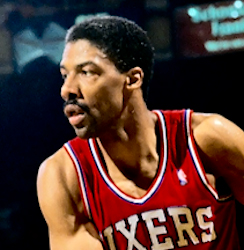Julius Erving (Part 1)
Julius Erving (Part 1)

Julius Winfield Erving II, better known as Dr. J, is a legendary figure in the world of basketball. Born on February 22, 1950, Erving played a pivotal role in legitimizing the American Basketball Association (ABA) and later made a significant impact in the National Basketball Association (NBA) after the merger of the two leagues in 1976.
Throughout his illustrious career, Erving achieved numerous accolades and milestones. He won three championships, four Most Valuable Player (MVP) awards, and three scoring titles with the ABA's Virginia Squires and New York Nets (now known as the Brooklyn Nets), as well as with the NBA's Philadelphia 76ers. Remarkably, Erving's teams never missed the postseason during his 16-year playing career.
Erving's influence extended beyond his on-court accomplishments. He popularized the slam dunk, showcasing his athleticism and creativity in dunk contests and games alike. His iconic free-throw line dunk in the Slam Dunk Contest remains one of the most memorable moments in basketball history.
Erving's impact on the game earned him recognition as one of the greatest players of all time. He was the only player to win MVP honors in both the ABA and the NBA. Additionally, he was named to various prestigious lists, including the NBA 35th Anniversary Team, the NBA's 50th and 75th anniversary teams, and the Basketball Hall of Fame.
Beyond his athletic prowess, Erving's style and grace on the court revolutionized the game. He transformed the slam dunk from a display of brute strength into an art form, showcasing finesse, athleticism, and creativity in his aerial maneuvers.
Julius Erving's contributions to basketball transcend statistics and awards; he left an indelible mark on the sport, inspiring generations of players and fans with his talent, innovation, and charisma.
Julius Winfield Erving II, known famously as Dr. J, was born on February 22, 1950, in East Meadow, Long Island. At the age of 13, he moved with his family to Roosevelt, New York, where he attended Roosevelt High School and began making a name for himself on the basketball court.
It was during his high school years that Erving acquired his iconic nickname. A close friend named Leon Saunders dubbed him "Doctor" or "Dr. J" as part of a playful exchange of nicknames between the two. The origin of the nickname stemmed from Saunders being called "the professor" and Erving adopting the moniker "the doctor" in response. This exchange of nicknames remained between the two friends until it gradually caught on with others.
As Erving's basketball career progressed, his nickname gained further traction, especially during his time playing in the renowned Rucker Park league in Harlem. There, he garnered additional nicknames like "Black Moses" and "Houdini." However, he insisted on being called "Doctor," which eventually evolved into "Dr. Julius" and then simply "Dr. J."
Interestingly, it was Erving's future teammate Willie Sojourner who first referred to him as "Dr. J" during their time playing together for the Nets and Squires. From that point on, the nickname became synonymous with Erving's legendary status both on and off the basketball court.
Julius Erving began his college basketball career at the University of Massachusetts Amherst in 1968. Over the course of two varsity seasons, he displayed remarkable talent, averaging an impressive 26.3 points and 20.2 rebounds per game. His remarkable statistical performance made him one of only six players in NCAA Men's Basketball history to achieve averages of over 20 points and 20 rebounds per game.
During Erving's college years, the NCAA had instituted a rule banning dunking, which meant that his renowned dunking abilities were only showcased during team practices, unseen by spectators. Despite this restriction, Erving's athleticism and skill were evident on the court.
In 1971, Erving sought early entry into professional basketball under the "hardship" provision, bypassing his remaining college eligibility to pursue a career in the sport.
Fifteen years later, Erving fulfilled a promise he had made to his mother by earning a bachelor's degree in creative leadership and administration from the University of Massachusetts Amherst through the University Without Walls program. Additionally, Erving was awarded an honorary doctorate from UMass in recognition of his achievements and contributions to the university and beyond.
In September 2021, the University of Massachusetts honored Julius Erving by unveiling a statue in his likeness outside the Mullins Center on the university's campus, commemorating his legacy as one of the greatest basketball players of all time and his enduring connection to the university.
References
- "Julius Erving Biography and Interview". American Academy of Achievement.
- ^ "NBA at 50: Top 50 Players". NBA.com. Retrieved February 18, 2022.
- ^ "NBA's 75 Anniversary Team Players". NBA.com. Retrieved February 18, 2022.
- ^ For Some N.B.A. Players, There’s No Such Thing as a Slam Dunk, The New York Times
- ^ J. Ted Carter. (September 1, 1971). "Patterned fast-break basketball". Retrieved July 20, 2015.
- ^ Golliver, Ben. (June 11, 2013). "Video: Julius 'Dr. J' Erving can still dunk a basketball at age 63". Sports Illustrated. Retrieved July 20, 2015.
- ^ Carson, Dan. (June 11, 2013). "This Video of Julius Erving Dunking at the Age of 63 Is Life-Changing". Bleacher Report. Retrieved July 20, 2015.
- ^ Harris, Robert L. Jr.; Terborg-Penn, Rosalyn (September 5, 2008). The Columbia Guide to African American History Since 1939. Columbia University Press. ISBN 9780231138116. Retrieved March 22, 2011.
- ^ "Dr. J operated above the rest". ESPN. Retrieved March 22, 2011.
- ^ "Julius Erving Summary". NBA.com. Retrieved March 22, 2011.
- ^ "Dr. J' Julius Erving explains his nickname exclusively to Class Act Sports". Archived from the original on March 29, 2012. Retrieved May 21, 2012.
- ^ Vincent Mallozzi. Doc: The Rise and Rise of Julius Erving. 60–61.
- ^ Bill Rhoden. "The Incredible Dr. J". Ebony. March 1975. 47.
- ^ "SOJOURNER DEAD AT 58". nypost.com. October 23, 2005.
- ^ "Julius Erving". umasshoops.com.





































